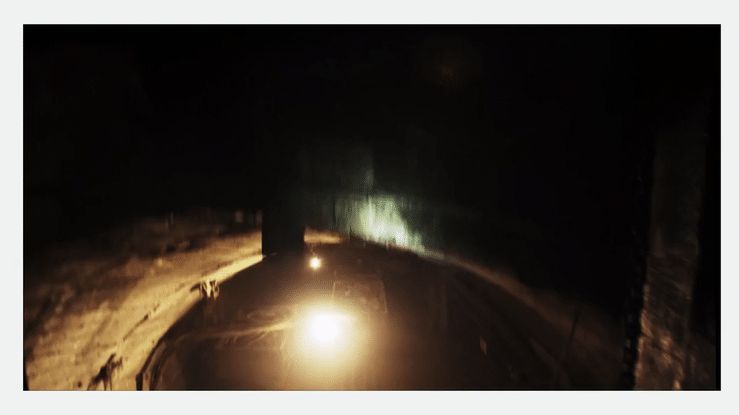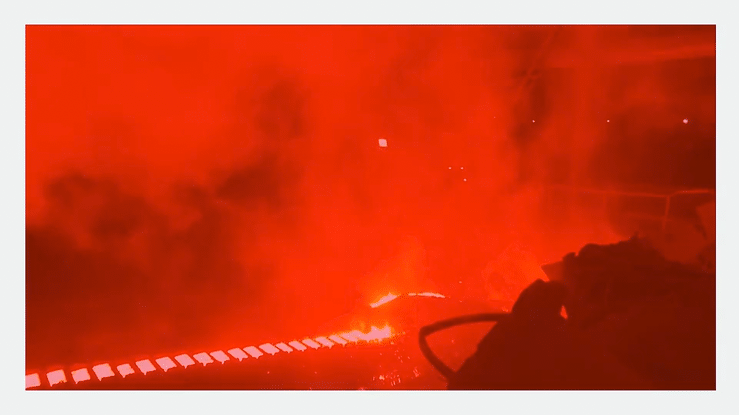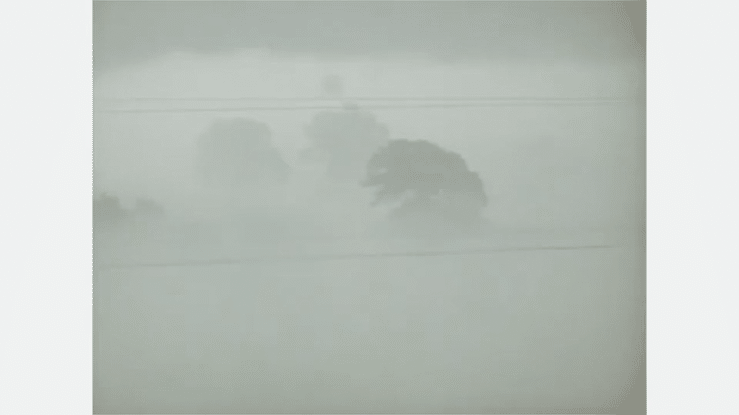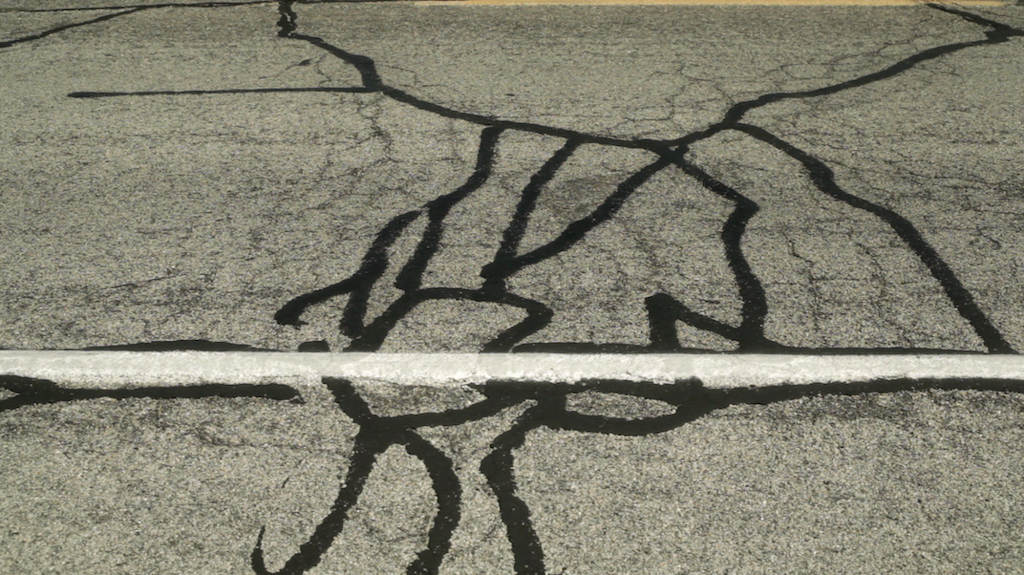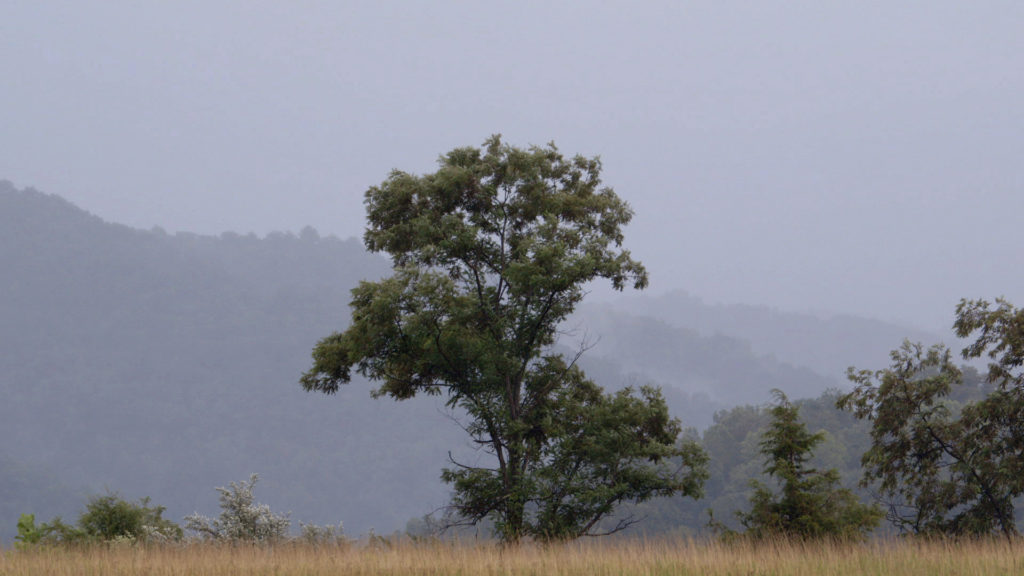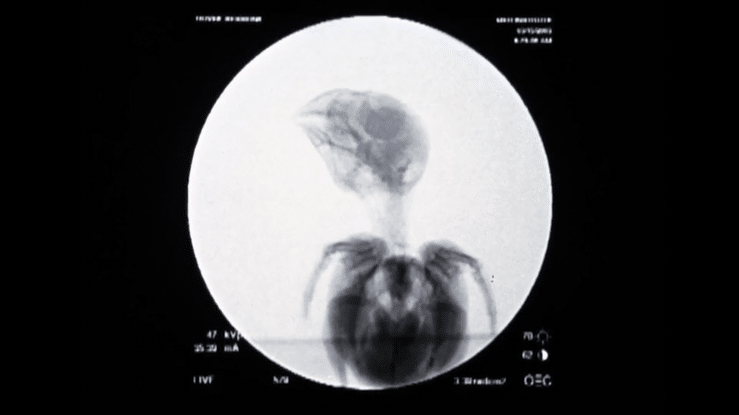Theories of the Earth: Surface and Extraction in the Landscape Film
Leo Goldsmith
The frontispiece of James Hutton’s Theory of the Earth, published in 1788, illustrates the Scottish geologist’s radical methodology for the history of the earth. The implication here is that the planet’s substructure—the literal ground we walk upon—serves as a historiographic inscription, an image of “deep time,” in which embedded temporalities take us beneath the immediate layers of recent history, down to the ancient and antediluvian epochs that lurk below. Rather than consider the Earth as eternally unchanged, or as the product of a linear trajectory from simple to complex forms of life, Hutton saw in the Earth’s layered substrata the record of a gradual cycle of erosion and sedimentation over time—beneath our feet and thus largely out of sight, but nonetheless available to read as history.
More recently, this image has served as something of a roadmap for the interdiscipline of media archaeology. In a 1996 essay, Siegfried Zielinski describes his interest in “dig(ging) out secret paths in history, which might help us to find our way into the future.”{1} This language of excavation is consistent with a long history of surface-depth metaphors that includes Freud’s theories of the unconscious, the Marxian morphology of base and superstructure, and Foucault’s own deployment of archaeology as an analogy for a project of discursive and epistemological excavation.
All of these theories position the subterranean, the underground, the buried or concealed as the vein of truth, in which meaning is understood as a treasure or a natural resource to be dug up. The surface is an obstacle: it is illusory, misleading, and must be transcended and penetrated in order for the subject to extract that which is deeper and, by implication, rarer and more precious. Indeed, we might note the air of suspicion and violence in the language of such metaphors: knowledge production is not simply a form of study analogous to geology or archaeology, but a process of mining and extraction.
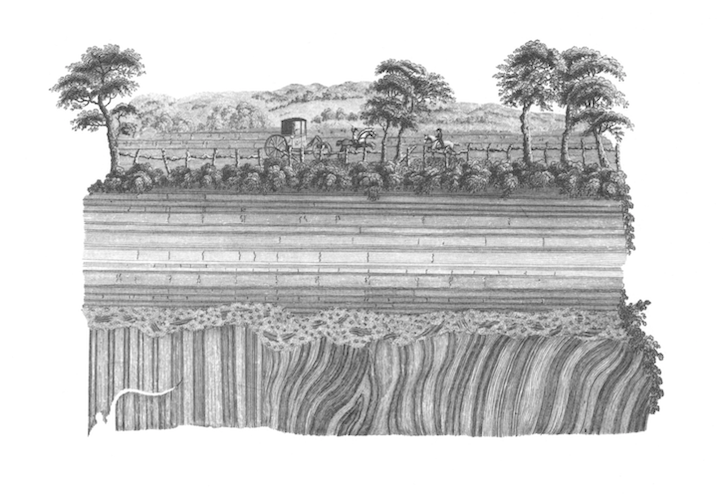 THEORY OF THE EARTH, James Hutton (1788).
THEORY OF THE EARTH, James Hutton (1788).
In more contemporary contexts, it is perhaps unsurprising that as technologies for the visualization and quantification of physical space become more sophisticated—including geographical information systems, deep mapping software, spatial narrativization tools, and point-cloud laser-imaging—metaphors of extraction are sustained still further by industries that extract data generated by our daily life.{2} Beneath the surface of everyday behavior—patterns of consumption, physical movements, and interpersonal relationships—lies a natural resource of information which becomes the object of a kind of mining operation using networked digital technologies. In these industries, Emily Apter notes, “slippages between conceptual and material associations,” are persistent in this field, beginning with the industry slogan “data is the new oil.” Apter writes:
What is underscored in this instance is not just the idea that data has displaced oil as the supremely valuable resource, but rather the subterranean or hidden aspect of data which must be extracted and refined, like oil, thus rendering “data-mining” the mode of production that best defines “mining” as an epochal episteme.{3}
Such a persistent set of metaphors thus suggests the extent to which all phenomena—the structure and contents of physical space, and all of the affects, activities, and patterns of behavior and accumulation that occur there—are so much precious data material waiting to be quantified.
Between these two moments—the Enlightenment-era project of mapping the Earth’s deep historiographic substructure, and the development of post-internet industries of quantification—emerge two images of the world framed according to the logic of extractive capitalism. Between these moments, optical technologies of photography and cinematography also emerge—as tools that seem to aid in a project of framing and extracting meaning from the world.
But what kinds of images of the world do photographic and cinematographic processes produce? Writing about documentary cinema, the filmmaker Michael Roemer claims that the camera “cannot function like an X-ray machine.” Instead, he argues, it is only the filmmaker’s “careful selection and juxtaposition” of surfaces—that is, montage—from which meaning is constructed or extracted.{4} The documentary camera registers surface phenomena—nothing more. And yet, images in documentary films and videos are regularly imputed with subjectivity; they are consistently deployed as metaphors or metonyms for larger social, political, or historical phenomena. Indeed, this tendency to utilize the immediate sensory information of surfaces might be said to be one of the core strategies of the documentary project. Surfaces, in these works, imply depths: they are the signs from which depth, that place of essential knowledge, might be excavated.
Are documentary’s images of the world’s surfaces also implicated in this project of literal and metaphorical extraction? Considering the long history of the photographic and cinematographic image’s deployment in projects of quantification and control, are they necessarily accomplices in the logic of extractive capitalism? Or might they be deployed, instead, as answers to that project, as ways of offering up sensory data in alternate ways that might question this logic?
Here, I want to address this question through an examination of a relatively extensive, but largely under theorized subgenre of experimental nonfiction moving-image practice known as “the landscape film.”{5} First emerging as a stable category with the postwar avant-garde in North America and Europe, and widely practiced within the festival and gallery-based spheres of contemporary nonfiction moving-image practices, these works primarily, and in some cases entirely, comprise the lens-based capture of natural or built environments in sequences of extended duration with little or no human figures or action.{6} Most importantly, this rather large and diverse body of nonfiction media utilizes landscape not as a contextual setting in which to situate action, but as the central object and a primary site for the production—or extraction—of meaning. In addressing this formally consistent and long- standing corpus, I will examine, first, their formal and rhetorical strategies and their relation to literal and metaphoric notions of surface and depth. Second, I will look at the ways in which several contemporary works sustain this practice in order to reconsider the notion of the landscape surface as the bearer of embedded “deeper meaning.” Contemporary landscape films persist at a significant moment—one in which postmodernist skepticism about the authority and veracity of lens-captured images of the world has become mainstream, and in which the planet’s physical spaces are subject to increased quantification and abstraction on the one hand, and transformations to its geography accelerated by capitalism-driven human activity on the other. Thus the underlying visual rhetoric of the landscape film, and how it conceives of the relation of “surface” and “depth,” serves as an important site from which to understand and interrogate cinema’s own image of the Earth and vision of the world.
What do landscapes tell us?
The history of visual culture—from painting to photography to film to digital media—has deployed the figure of the landscape to provide a visualization of space conceived variously as a natural environment, a territory or terrain, or as a site of human and/or interspecies relationships. In the history of the narrative moving-image, landscapes are consistently framed in establishing shots which, from John Ford’s Monument Valley to Yasujiro Ozu’s suburban Tokyo, situate the characters and actions of stories within spatio-temporal settings that can be specific, actually existing sites; fictitious places; or montaged pastiches of the two. Establishing shots serve similar functions in nonfiction media as well, providing images of profilmic spaces in ways that draw upon their significance as, alternately, specific cultural or historical sites; metonymic stand-ins for larger institutional or ideological frameworks; or exemplars of a particular pictorial beauty.
Images of landscapes or their surfaces, then, acutely address the question of surface versus depth in their presentation of physical space by offering, first, a plane of immanent sensory data captured by the lens and sensed by the spectator, and second, and perhaps more crucially, the hint of something “beneath” or “beyond”—a metaphorical space that allows one to access layers of implication within the image. In cinema generally—and perhaps particularly in those films which rely almost entirely on images of landscape—the surfaces of environments rarely exist solely for or as themselves. Their meaning is only derived through a process of reading—an act of extrapolation that would seem to invite the viewer into the metaphor of extraction. Here, the film and the spectator collaborate in an extractive reading of the landscape.
Patrick Keiller, whose work concentrates primarily on cityscapes and their architectural or infrastructural features, makes such an assertion in his writings on the depiction of landscape in art, photography, and cinema over the last two centuries. For Keiller, the filming of landscapes involves a complex process in which surfaces conjure in the mind of the viewer a sense of both the historical past and the possible futures of the spaces represented. He writes:
Landscape functions in all these ways in the cinema, perhaps more so than anywhere else. The tragic-euphoric palimpsest; the reciprocity of imagination and reality; place seen in terms of other place; setting as a state of mind—all are phenomena that coincide in films.{7}
Each of these effects of landscape images thus activates in the mind of the viewer “an implicit critique of similar spaces of the present, and can inform our understanding of the ways in which urban and other landscapes change in time.”{8} The image of landscape, therefore, is not limited to that space’s surface, but is a densely layered codex of meanings, temporalities, affects, and “states of mind.” Critique, for Keiller, becomes a tool of extraction in which these meanings might be accessed, as it were, beyond or beneath a landscape’s surface image.
Himself a maker of landscape films, Keiller draws an explicit connection between this practice and a long lineage of landscape portraiture in other spheres of artistic practice—from painting and panoramas to photography and film. Indeed, images of landscape first emerge at the very beginnings of cinema in the form of actuality films, phantom rides, and Hale’s Tours of the World. But the landscape film as a subgenre seems to solidify as a confluence between avant-garde or experimental cinema and the documentary tradition in the postwar period. The scholar Scott MacDonald identifies the notion of an experimental documentary under the general heading of “avant-doc,” which he has theorized as an alliance that emerges from “both the history of filmmaking and the history of the alternative exhibition.”{9} That is, while MacDonald notes the aesthetic intersection of documentary and the avant-garde at least as early as the “city symphonies” of the 1920s and 30’s—themselves precursors to the landscape film—he also situates their joint project within specific exhibition contexts in the postwar period (notably the Art in Cinema Film Society in San Francisco and Berkeley, and Amos and Marcia Vogel’s Cinema 16 in New York City).{10} Thus, an understanding of the parallel lineage of the documentary and avant-garde or artists’ cinema traditions is crucial to the understanding of the context in which experimental documentary—of which the landscape film is a subspecies—are produced and received today. These works circulate primarily, perhaps almost exclusively, through film festivals and arts institutions such as museums and galleries.
This shared context might explain why the form of the landscape film has remained so consistent across several decades, continents, and moving-image media formats (35mm and 16mm film, and digital video).Indeed, while this type of practice is perhaps primarily associated with North American experimental and documentary filmmakers—of which James Benning’s film and video work from the late 1970s to the present is perhaps the most obvious example—the landscape film is a global and remarkably durable form that arises in a surprising number of contexts over the last half-century. Similar practices can be found in, for example, North American postwar avant-garde and artist’s cinema (including the “structuralist” films of Larry Gottheim and Michael Snow; and continuing with the work of Peter Hutton, Thom Andersen, Sharon Lockhart, Travis Wilkerson, and Jem Cohen); the moving-image work of practitioners of Land Art such as Nancy Holt and Robert Smithson; films by Western European auteurs such as Chantal Akerman, Babette Mangolte, Danièle Huillet and Jean-Marie Straub, Heinz Emigholz, Nikolaus Geyrhalter, and Patrick Keiller; and in the radical Japanese cinema of the late 1960s (Masao Adachi, Hara Masato, and Takamine Gô). Recent films and videos—including The Otolith Group’s Medium Earth (2013), Zhao Liang’s Behemoth (2015), Deborah Stratman’s The Illinois Parables (2016), Eric Baudelaire’s Also Known as Jihadi (2017), and Sky Hopinka’s Jaajì Approx. (2017) continue this tradition of landscape film for a variety of different ends. While there are indeed variations among these many disparate examples—and indeed not all of the work of all of these filmmakers falls into the “landscape film” category as such—all have produced works that rely on the form’s primary attribute of long-duration, lens-based capture of environments.
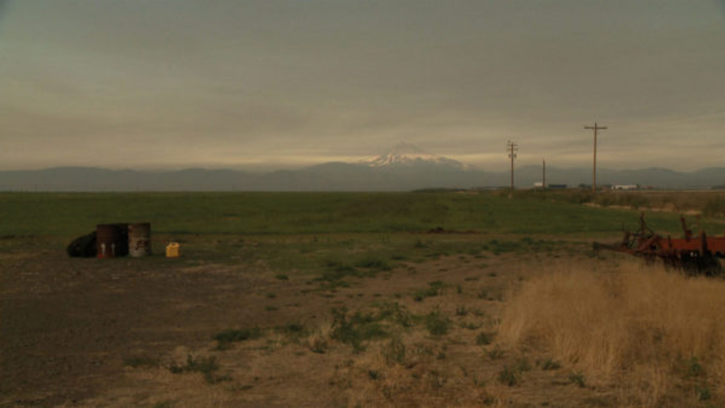 STILL FROM L. COHEN, James Benning (2018).
STILL FROM L. COHEN, James Benning (2018).
But how precisely does this experience of viewing the filmed surfaces of landscapes create meaning? And why has this form been sustained across time, geography, and medium format? To the extent to which these works rely upon, even demand, patience and curiosity from the viewer, and generally eschew overt narrational devices (such as voice-over) to direct the viewer’s attention or interpretation of the images, what knowledge do they propose to offer the viewer via the lens-based capture of landscape?
We might look to the career of James Benning, the filmmaker who has most extensively and consistently utilized landscape in his work as a way of understanding the sheer variety of modalities, styles, and medium formats by which landscape film produce meaning. In his filmography alone, landscape films have taken the form of analog, long-take assemblages (One Way Boogie Woogie (1977)), Landscape Suicide (1987)) and, more recently, single-shot digital videos (L. Cohen (2018)). Benning has constructed films from footage of landscapes with slight addition or modification, such as a text overlay (Deseret (1995)); recreated his own earlier landscape films (One Way Boogie Woogie / 27 Years Later (2005)); and “remade” works by other filmmakers consisting entirely of landscape images (e.g. Easy Rider (2012)). Similarly, these films represent landscapes in multiple ways, sometimes within the same film, as an object of contemplation (e.g. the California trilogy: El Valley Centro, Los, and Sogobi (1999–2002)), an index of specific historical events or incidents (Landscape Suicide), or a symbol of larger historical, political, or natural processes (e.g. RR (2007)).
As Benning stated in a recent interview:
I liked looking at landscapes. I liked what they were aesthetically, but I also liked to see how the history is written into the landscape through historical events that might have occurred there…I started to learn from looking closely. And it was more about just the understanding that having patience brought something to you always—you could always see something new happening over time.{11}
Thus, for a maker of landscape film like Benning, the meanings of landscapes may variously be derived metaphorically (from the symbolic iconography that the landscape may evoke), metonymically (from the landscape’s capacity to suggest larger territories or similar topographical or geographical conditions), or phenomenologically (from the durational experience of watching the landscape). The surfaces the camera captures may suggest geological substructures and processes, or the traces of the history that is buried beneath them. The duration of filming may simply allow us to experience a version of this landscape in “real time,” standing in for longer durations of historic or even geological time. In these works, the filming of the planet’s surface functions as a means of exploring both a set of immediate sensory data and what we might call its “embedded” meaning, its deeper connections with historical, subcultural, or otherwise invisible phenomena.
Larry Gottheim’s 1970 film Fog Line, an early classic of landscape film, illustrates some of the ways in which these meanings might be derived by the spectator. Gottheim’s film begins as an abstract grey-white color field of which its only feature is a set of power-lines that bisect the image. Over the course of the film’s eleven minute duration—the length of the 16mm film reel that Gottheim used to shoot the scene—the line of fog slowly lifts, revealing features of the landscape beneath the fog: trees, grass, animals, or, in other words, the natural scene which, at the start of the film, was obscured by fog. Over the course of Gottheim’s film, the fog quite literally peels back layers for the viewer, unveiling a landscape in depth.
from FOG LINE, Larry Gottheim (1970).
What’s notable about Gottheim’s film is the way in which it concisely maps the temporal onto the spatial: as a “structural” film, Fog Line’s duration is dictated by the length of the film reel, while the contents of images are determined by the drifting fog as it reveals the landscape. The film thus asks the viewer to understand and apprehend the landscape at the same pace as the fog line’s movements—it asks that we attune ourselves to the temporality of the fog and, metonymically perhaps, of the natural world as a whole. If one refuses or is unable to do this, one crucially “misses” certain elements of the film, such as the famous, barely visible deer that traverses the image for a brief moment before disappearing. But the film’s structure allegorizes this process of the spectator’s “attunement to the pace of nature” through its framing and structure. At first, we only see the grey and the power lines, the latter a clear indicator of human technology’s presence; by the film’s end we see more and, more importantly, we see past the index of human intervention in the foreground of the image to that which lies beneath it—that is, the natural world.
Of course, in watching and interpreting Fog Line, one could argue the contrary: that instead of determining or attuning the spectator’s gaze to particular details, the film rather allows her a free play of apprehension and understanding; and that the film’s structuralist devices (i.e. the fact that its editing is determined by the film reel’s length and its imagery by the fog’s movements) demonstrate that the landscape is undetermined in its meaning. According to this argument, Fog Line functions precisely because it does not instrumentalize the landscape in the service of a particular set of meanings—its meaning is rather endlessly elusive and open to any encounter that the particular spectator might have with it.
While I do not wish to argue that this understanding of the film is in any way incorrect, I want to suggest here that the notion that its landscape is therefore not instrumentalized — freely open to the spectator’s playful gaze, and undetermined in its meaning — is nevertheless illusory. Even while Fog Line offers an image of landscape that is, for the most part, “open to interpretation,” the film invites, even demands, that the viewer develop a probing gaze, one that looks closely to seek out the apparently hidden traces of the landscape. Its function is, at least in part, to attune the viewer to a particular type of visual attention that can in some way find meaning and value within the image, even if the particular meaning to be extracted is not determined in advance by the filmmaker or the film.
Fog Line is consistent with a grouping of experimental nonfiction works that MacDonald has called “eco-cinema.”{12} For MacDonald, these works—which include films by Benning, Hutton, Diane Kitchen, and J. P. Sniadecki—use durational cinematography of landscapes for two ends: first, to “create the illusion of preserving ‘nature’”—or more precisely, “provide an evocation of the experience of being immersed in the natural world”{13}; and second, to offer “audiences a depiction of the natural world within a cinematic experience that models patience and mindfulness—qualities of consciousness crucial for a deep appreciation of, and an ongoing commitment to the natural environment.”{14} In other words, for MacDonald, these works offer at once an approximate encounter with the natural world, but also attune the viewer to a different mode by which to receive that experience. MacDonald thus places eco-cinema in explicit contrast to what he identifies as a “cinema of consumption”: such as commercial action cinema, which by contrast is marked by an acceleration of images and sounds, and by the literal consumption of food and drink that accompanies it. For MacDonald, eco- cinema’s very slowness—its durational forms, its patient yet insistent attention to landscapes viewed often in long-takes—both preserves an experience of the world and retrains the viewer to experience and understand it properly through an alternative form that seems to resist consumption in its more crass and accelerated forms.
MacDonald’s notion of the “eco-cinema experience” is less about arguing for direct results of watching particular types of films and videos, and more about proposing that these works might, as he states, “play a small but useful role” in prompting spectators to consider their positions as both stewards of environmental protection and consumers of media.{15} Nevertheless, a question arises in MacDonald’s opposition of “eco-cinema” to a “cinema of consumption”: is one necessarily more ecologically mindful than the other? As I have argued in relation to Gottheim’s film, the opposite could just as well be true: that the durational experience of eco-cinema demands that the spectator regard the image as a source of data to be extracted—it invites the viewer to consume as much from it as possible. For MacDonald, these films model experiences of patience, immersion, and appreciation for the spectator, but they could just as well model activities that render these natural places abstract, quantifiable, and subject to extraction.
By the same token, MacDonald’s distinction between an eco-cinema and a cinema of consumption may be less sharp as it first appears. In defining the latter, MacDonald states that eco-cinema is the inverse of the fundamentally hysterical approach of commercial media, and advertising in particular, where consumption of the maximum number of images per minute models unbridled consumption of products and the unrestrained industrial exploitation of the environment within which these products are produced and consumed.{16}
If the “hysterical approach of commercial media” models “unbridled consumption,” does not eco-cinema model its own visual rhetoric of extraction and quantification? What precisely distinguishes these two gazes, these two modes of looking? Indeed, eco-cinema and the cinema of consumption are produced using the same media technologies, an obvious fact that would nevertheless seem to undermine any claim that images can defy or resist consumption. All media is in some way consumed, and all of it, without exception, is bound up in materials, processes, and technologies that not only derive from the planet’s resources but also inevitably generate waste and toxify these same environments. “Embedded in every moving image,” as Nadia Bozak reminds us, “is a complex set of environmental relations.”{17} Under conditions of widespread ecological precarity—brought upon by human activities of resource extraction and exploitation of which the media industry is a part—do landscape films simply participate in an alternative model of exploitation and extraction, offering us in return simply more images to consume, and more resources to extract and exploit?
If images of landscapes are always surfaces to be penetrated in pursuit of extractable knowledge, then landscape film—and perhaps documentary cinema as a whole—might be conceived as part of the same alignment of optics and power that Macarena Gómez-Barris calls “the extractive view.” Gómez-Barris deploys this term to refer “to state and corporate logics that map territories as commodities rather than perceive the proliferation of life and activities that make up the human and nonhuman planetary.”{18} This view, Gómez-Barris observes, defines landscape as territory for resource exploitation, visualizing its configuration of resources—human, material, and aesthetic—as a prospectus for extracting its assets and their attendant value. “Before the colonial project could prosper,” she argues:
it had to render territories and peoples extractible, and it did so through a matrix of symbolic, physical, and representational violence. (…) This viewpoint, similar to the colonial gaze, facilitates the reorganization of territories, populations, and plant and animal life into extractible data and natural resources for material and immaterial accumulation.{19}
By aligning my own critique of landscape film with this theorization of the “extractive view,” I argue that documentary images of landscape in film and video take up a position that is—at least aesthetically and perhaps ideologically—isomorphic with those means by which state and corporate infrastructures have visualized the objects of their own projects of extraction and colonization. Recall again the Hutton frontispiece: here is a conception of the earth as a surface embedded with other surfaces, a spatialization of historical data, that is also a roadmap for mining and quarrying. History is visualized as a resource, as extractable from the landscape as sandstone, limestone, granite, basalt, or felsite. Indeed, the Hutton illustration derives from the tradition of the “cutaway drawing,” an aesthetic genre of the Renaissance which offered the viewer access to spaces usually inaccessible to those on the surface via a kind of X-ray optical mastery.{20}
Genres of illustration like the cutaway find clear descendants in contemporary tools of optical mastery, such as point cloud laser scanning used in contemporary mining, millimeter wave X-ray scanners used in security checkpoints, and a wave of emerging technologies in the field of biometric surveillance. So how might the visualization of landscapes using more traditional means of lens-based capture take up or even model an “extractive view”? Or, conversely, in what ways might landscape film serve as a medium for correcting, rejecting, or critiquing an extractive point of view and the logic of an optical mastery over landscape?
Here, I would like to turn to a discussion of several contemporary moving-image works that operate in or around the mode of “landscape film” as I have defined it; films, videos, and installation works that utilize durational moving images of natural or built spaces in order to address and complicate the notion of landscapes, their aesthetics, their meanings, and their status as sites for the extraction of natural and informational resources.
Medium Earth, a 2013 installation video by London-based collaborative The Otolith Group, assembles images filmed in interior and exterior spaces in Southern California (Los Angeles, Palmdale, Yucca Valley, and Joshua Tree National Park). These images, which include static wide landscape portraits, lateral pans along horizons, closeups of details of individual structures or objects, and overhead compositions of ground surfaces, trace a path from the cracked concrete flooring of an empty parking garage through to desolate deserts, mountain ranges, anthills, and highways. In an artist statement, the Group describes the work as an “accumulation of moving images and sounds” that make up “an audiovisual essay on the millennial time of geology and the infrastructural unconscious of Southern California.”{21} In this way, at the level of the work’s images, the Group declares a certain affinity with artistic predecessors, such as Patrick Keiller, whose images of landscape suggest the geological history embedded deep within natural and built materials and structures—a palimpsestic structure of landscape, which can be accessed, as it were, at the surface level.
At the visual level of the work, however, it is not immediately clear how such a work of interpretation or access—or indeed meaning-extraction—might be possible. We see boulders, asphalt, and parched valleys, but little visual confirmation of a connection between these relatively banal objects and their historical, or geo-historical, content. There is, perhaps, the sense that this information might be gleaned from the work’s montage, its comparative assembly of these images within the work. But primarily we understand the work’s embedded content, as it were, from its textual accompaniment: first, the voiceover that, at certain moments, coincides with the images; second, the artist statement.{22}
“What do faults promise?” the voiceover begins, approximately halfway through the forty-minute video. The question suggests, of course, an anthropomorphic agency on the part of geological formations. But it also betrays a pun: is there a false promise secreted in the imagery of fissures in a rocky landscape? Pointedly, the voiceover prioritizes senses other than vision in its investigation of the landscape: “We feel faults below 2.0; thousands of us feel them, straining, building stress in the shale, folding rocks into compressed curves. Some of us hear faults at higher frequencies, some hear the sub-sonics of slip faces.” Here, Medium Earth’s text alludes to the work of self-described “Pioneer of Biological Earthquake Forecasting” and seismological “sensitive” Charlotte King, who claims to feel small seismic shifts and hear subsonic movements of the Earth.{23} Thus, the work calls into question the hierarchy of senses usually established within the cinematic medium. The landscape images alone tell us little; but the soundtrack suggests new methodologies for understanding these images, hinting at the presence of alternative epistemological systems to be accessed via other senses: namely, smell and touch. “It hurts,” the voiceover continues, “the sounds, my symptoms, the smells, they keep coming back in waves.” Allusions to scents (“The aroma of cut aluminum, sheet metal, the memory of creosote, an electrical cord is burning, batteries are venting, grapefruit and lemon and watermelon and orange”) and to tactile phenomena (“groping fingers,” the pain of headaches and earaches) establish an alternate mode of reading the images we see. In doing so, they aim to represent landscape not as image—as the purely visual object of a gaze that could be mindful or extractive—but as an environment with which the human body itself is intimately interconnected. “We are gases, ignited by the earth’s nocturnal core, three thousand clicks below the cold crust, the semi-fluid metallic ocean, the geo-cosmic motor, the shifting face of the earth.”
This phrasing might be understood to imply that the earth’s surface—its “cold crust”—is deceptive, masking something more essential hidden from sight. The image, in this reading, blocks more than it reveals. And yet, the work’s second textual source, the artist statement, offers a slightly different reading—one that is perhaps aspirational but nevertheless revealing of the intentions behind the work and the project of landscape film more generally. “The desire to evoke the hidden substrata of the planet gives way to a morphological interpretation of the face of the earth.”{24} First, this sentence’s foregrounding of a “desire” that “gives way” may be understood to indicate the insufficiency of a gaze that seeks to penetrate surfaces in search of a hidden meaning. But, furthermore, the arrival at a “morphological interpretation” hints at a reliance on a degree of formal abstraction in the visualization of landscapes. Images of landscape, then, do not visualize that which is beneath them; they betray a desire for mastery over landscape that can only be satisfied via an indirect systematization. Reinforcing this, the video’s end credits are accompanied by an entirely different—and still more abstract—visual mode: in place of the lens-based capture of surfaces, we see a set of 3-D renderings which model the activity beneath the surfaces of the earth. Within the logic of the work, this might be understood as the exchange of one mode of formal abstraction for another.
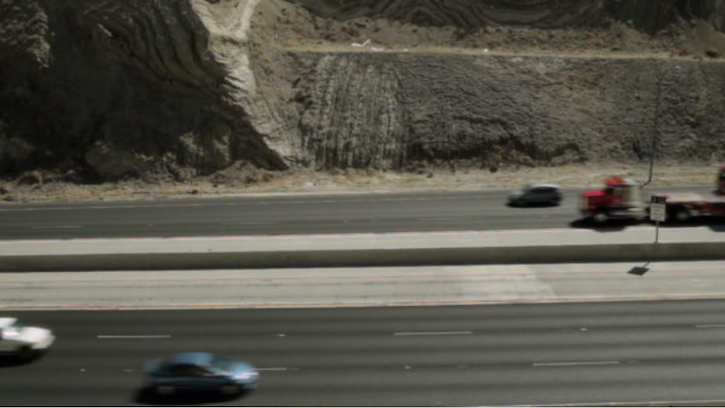 MEDIUM EARTH, The Otolith Group (2013).
MEDIUM EARTH, The Otolith Group (2013).
In this sense, Medium Earth offers a critique of the “extractive view” without fully rejecting its desires for a mastery over landscapes and that which is embedded within them. The work retains this desire, even if this approach must give way to other means of understanding an experience of landscape beyond a direct optical encounter. Nevertheless, in understanding images of landscape precisely as images—as less a mineable surface and more an abstraction that veils a set of desires, two-dimensional abstractions of three-dimensional environments—the video is consistent with the critique offered up by those who, like Gómez-Barris, situate such representations within histories of extraction and colonialism.
Two audiovisual works that are still more emphatic in this regard are Zhao Liang’s Behemoth (2015) and Sky Hopinka’s Jáaji Approx. (2016), both of which foreground the processes by which landscapes are rendered imagistic. These works achieve this not through lens-based capture alone, but through both subtle and extreme interventions into the image at the moment of postproduction. Zhao’s film, for example, depicts the ruptured landscapes of mining operations in Mongolia with the images that are themselves ruptured: he captures images of sites of extraction and later intervenes into the frame with what appear to be “cracks” in the image, suggestive of the reflections in a shattered mirror. This fragmentation of the image, at one level, can be read as isomorphic with the fragmentation of the landscape, as dynamite blasts through layers of crust in search of coal and copper. But more importantly, the schism also signals a break in the representational capacity of the cinema, registering a mutability of the image that is coextensive with the mutability of the earth itself under the logic of extractive capitalism.
BEHEMOTH, Zhao Liang (2015).
Sky Hopinka’s video similarly emphasizes the constructedness and two-dimensionality of the landscape portrait through a manipulation of the captured image. Here, Hopinka’s footage is subject to various postproduction interventions: the superimposition of images upon images; the inversion of color balance or 180-degree rotation of the image; and, most importantly, the layering of text over the image. Like Medium Earth, Jáaji Approx. juxtaposes its treated images of landscape with two textual overlays: first, archival audio recordings in which the artist’s father discusses songs and traditions of the powwow; and, second, onscreen text that transcribes portions of the recordings into a form of phonetic notation common to anthrolinguistic practices. The result is an image of landscape that is constantly being reframed or positioned in relation to pre-existing schemas of knowledge production. While the landscapes have meanings and associations specific to the artist and his father—which, incidentally, are deliberately withheld from the viewer— they are also subject to the manipulations Hopinka brings to them after the fact. With the textual overlay, they also become bearers of projected meanings: patterns, schema, and grammars that suggest attempts at mastery through interpretation and knowledge but never fully harmonize with the depicted landscapes themselves.
As a Native artist of the Ho-Chunk and Pechanga tribes, Hopinka frequently challenges documentary and ethnography in his work via a resistance to conventions of cultural interpretation and translation. In an interview with Ojibway artists Adam and Zack Khalil, Hopinka states:
I always heard about Western entitlement around knowledge, this idea that if something exists, then we have a right to know about it as scientists, scholars, academics, or whatever. I really resist the idea that just because something exists, just because something has the opportunity to be studied or documented, then it should be. I’m a big fan of the mystery of culture, and how certain people have access to information that others don’t.{25}
In Jáaji Approx., the overlay of phonetic text on images of landscapes accentuates a disconnect between anthropological systems of transcription and codification on the one hand and alternate knowledge systems on the other. Here, the image of landscape itself is not so much called into question—it is not quite the veil we see in Medium Earth—rather, it is a surface, a screen for the projection of patterns that seek to predetermine meaning and interpretation. But these meanings and interpretations are themselves constantly in flux, and for Hopinka landscape functions less as an object of study to be mastered than a space of interrelation in which its meaning is never fully fixed. Hopinka: “(G)oing back to distance, traveling, landscapes and all that—again, it’s searching for my place within these different landscapes or relationships with people in a specific place.”{26}
JÁAJI APPROX, Sky Hopinka (2015).
These works stage a shift away from the notion of landscape as a fixed image for interpretation and meaning-extraction to that of an ever-shifting milieu of interrelation, opening the image of landscape to different modes of engagement and knowledge-production. In these works, landscapes do not represent—by metaphor or metonymy—a set of conditions or concepts, nor are they simply screens on which such ideas are projected. Rather, these landscapes are themselves immanent to and inextricable from these concepts and conditions—they are, in a sense, produced by them.
Brett Story’s The Prison in Twelve Landscapes (2016) and Deborah Stratman’s The Illinois Parables (2016) do not wholly conform to the genre of “landscape film” as I am defining it here, and yet both films at times make use of its style of fixed-frame, durational cinematography of natural and built spaces in the mode of the works I have discussed so far. What is distinctive about both works is the way in which they present landscapes not as objects of an interpretive or extractive gaze, nor as emblematic or representative of a set of conditions, but precisely as spaces that are produced by a set of historical or institutional logics. In Story’s film, for example, geographic spaces are not settings for an investigation of the role of incarceration in contemporary American life, nor are they symbolic of its effects on local communities. Rather, these landscapes are specifically produced by the actors and institutions of the prison system—they are inextricable from it, and not simply representative. For example, in a segment set in eastern Kentucky, poverty and underdevelopment are inscribed in local topography: extractive capitalism in the form of surface mining has flattened mountaintops, making them available for reclamation as land for a federal prison (and an airport that services it). These shots of landscapes do not serve as indices of the precarity of local communities and exploitation of their labor and resources; rather, these factors are visualized in Story’s film as directly constitutive of the landscape and its features.
Story’s film dismantles the conventional opposition between surface and depth that accompanies the landscape film: the image of landscape is not a veil for deeper, hidden meaning, but part of the same immanent set of relations which extends outward to include the spectator herself. Deborah Stratman’s films about landscape operate in similar fashion, not just representing landscape’s legible image, but also pointing toward its inseparable connection with the historical and economic contexts which produce it. One of several films Stratman has made that rely heavily on durational shots of landscapes, The Illinois Parables illustrates eleven historical narratives from the history of the state of Illinois, utilizing a range of found and original material: onscreen text and voiceover narration; archival footage and sound; observational footage and reenacted sequences. But central to each of these are Stratman’s lengthy, static 16mm moving images of the Illinois landscape. Stratman’s emphasis on the relationship between surface and depth in many of her subjects—burial mounds, nuclear waste storage sites—would seem to suggest a palimpsestic understanding of landscape, identifying it once again as a resource of “deep meaning.” The sites she selects would seem to be deeply embedded or layered with historical meaning, which her camera’s attention seems to be uncovering or extracting. In various instances, too, Stratman reinforces this by laying text over the image in a manner similar to Hopinka’s film. For example, in one image, the text of the congressional edict that would expel Native Peoples from their land in the southeastern United States to lands west of the Mississippi is placed over a shot of that very route as captured by Stratman’s camera.
But, here again, history is not simply evoked by the presentation of places where historical events have occurred. It is inscribed in the landscape—and sometimes literally signposted, as in the shot of a street sign for “Trail of Tears Rd.” framed against a desolate southern Illinois roadway. Such an image does not simply recall or evoke events that are lost and in need of a literal or metaphorical unearthing; rather, it suggests that this history exists even in the present, inscribed upon and situated directly within that landscape. These are not, therefore, buried histories, obscured by time and in need of extraction or extrapolation, but histories that continue into the present and are inscribed materially on the land’s surface. Stratman’s film seems to imply that to position these events as somehow remote to us, accessible only via an extractive process that goes beyond the surface, is to ignore the ways these events continue to exist and unfold in the present.
from THE ILLINOIS PARABLES, Deborah Stratman (2016).
Above, this essay posed a question: what do landscapes tell us? In fact, perhaps the more relevant question would be: must landscapes tell us anything? In a historical epoch in which physical space is increasingly privatized, enclosed, and excavated—rendered unlivable, immaterial, or monetizable—what are the ethics of representing landscape, and does this activity necessitate a further exploitation of space as image, data, or form?
The works and artists I have discussed here grapple with these questions, seeking new aesthetic forms between humans and environments outside of purely extractive or exploitative relations. For these artists and filmmakers, the task is not to withdraw from representation—to relinquish the capacity of artists to represent and understand space as such—but to engage new modes through which to understand landscapes and the means by which their meanings are produced in relation to human activity and desire.
I wish to close with a final example that illustrates at once the stakes of this endeavor and the shift that the mode of landscape film has undergone in recent years. Eric Baudelaire’s Also Known As Jihadi, from 2017, offers images that follow the story of a young man from the suburbs of Paris to Syria to join the Al-Nusra Front (al-Qaeda)—images that, according to Baudelaire, draw upon “two kinds of landscapes: geographic landscapes shot with the camera, and judicial landscape revealed in excerpts of documents produced by the police and the courts.”{27}
Baudelaire’s method of working with landscape derives from a model provided by the Japanese filmmaker Masao Adachi in his 1969 film A.K.A. Serial Killer, a film composed entirely of quotidian town and landscapes from across Japan that apparently track the development of its subject, Norio Nagayama from his working-class upbringing to the moment, at nineteen years old, when he was sentenced to death for the murder of four people. In a manner similar to Stratman’s film, Adachi’s work insists on the immanent legibility of social and historical conditions in the landscape—their literal inscription in the surface of the earth, rather than the metaphorical or metonymic extrapolation of their meaning. And, in many ways, Baudelaire’s film seems to offer something similar in its account of its subject. The program notes for a screening of the film at the Tate Modern, for example, invite viewers to: “Trace a young man’s path to radicalization through landscapes and court transcripts in this timely film.”{28}
But Baudelaire has emphasized in interviews that, rather than offer landscapes and state-produced documents as the bearers of immanent and interpretable meaning, his film aims at pointing precisely to their failure as definitive texts through which to understand the life of his subject: “I use the landscape theory (…) because I accept the notion that it fails, (…)(Like) the surveillance and judicial documents … (t)he(se images) tell a story. But it’s the story told by the state surveillance and judicial apparatus in the face of a phenomenon it doesn’t really know how to process.”
Thus, images of landscapes and images of official documents in Baudelaire’s film are surfaces that impart only partial knowledge—and, furthermore, they are dangerously open to misinterpretation. On the one hand, the narrative suggested by this interpolation of surfaces—their extractable content—is one of the radicalization of a French-Muslim teenager. But at the same time, the attention that Baudelaire’s images give, first, to the textural and affective experiences of these surface and, second, to their situatedness in emphatically handheld cinematography, troubles the narrative of inevitability these surfaces would seem to present.
Does this mean that the landscapes, like the documents, tell us nothing? Is Also Known as Jihadi, then, a ninety-nine-minute film of images that are useless or arbitrary, completely available to misinterpretation or instrumentalization in the service of a fatalistic certitude about the conditions of contemporary life? Baudelaire himself suggests otherwise: that these surfaces become what he calls “a contradictory empathetic space—a very just place from which to view the world and try to untangle what we learn from our observations of it.”{29}
Baudelaire’s film positions images of landscape as, indeed, mutable—perhaps dangerously, deterministically so. At the same time, it also suggests that these images are necessarily contestable spaces: they are not surfaces behind which a truer interpretation or extractable content lies, but emphatically the ground on which meaning is co-produced. In this way, Baudelaire disassembles the image of landscape as an extractable set of data, positioning us within it as actors rather than consumers. Here, we find a clear echo, or even extension, of MacDonald’s “ecocinema experience”: one that models for the spectator behaviors of patience and mindfulness. And yet, the space Baudelaire creates through his film is less one of contemplation and more one of action. The film does not offer an experience or model behavior; it demands an active form of intervention.
Landscape films offer ways of conceiving the world, but that world is inevitably bound up with cultures and economies of consumption and extraction. If these films are to resist these cycles at all, or at the very least to help dictate their terms and directions, it is not by producing more media to consume and read, but by positioning images as inextricable from the terrain of interrelation. It is by positioning landscapes not so much as spaces for contemplation than as spaces of action.
{1} Siegfried Zielinski, “Media Archaeology,” ctheory.net, (July 1996). See also Jussi Parikka, A Geology of Media (Minneapolis: University of Minnesota Press, 2015), 11.
{2} For a discussion of the use of these technologies, see Jennifer Gabrys, Program Earth: Environmental Sensing Technology and the Making of a Computational Planet (Minneapolis: University of Minnesota Press, 2016); and Lisa Parks’s work on the use of satellite in Cultures in Orbit: Satellites and the Televisual (Durham, NC: Duke University Press, 2005), 76-107; and Parks, “Digging into Google Earth: An Analysis of “Crisis in Darfur,”” Geoforum 40 (2009): 535-45.
{3} Emily Apter, “Overburden,” e-flux (April 2017).
{4} Michael Roemer, “The Surfaces of Reality,” Film Quarterly 18, no. 1 (Autumn 1964), 15. Roemer suggests that it is only through the juxtaposition of images via montage that meaning can be derived—extracted—from surfaces. Bill Nichols offers a similar suggestion when he states that “(a) photographic image represents the visible event, not the motivation. Subjectivity eludes its grasp.” See Bill Nichols, Representing Reality: Issues and Concepts in Documentary (Bloomington: Indiana University Press, 1991), 153.
{5} While many of the works I discuss here are videos and not films, I retain the term “landscape film” as it is a fairly common designation within film criticisms on a widespread and recognizably consistent corpus. See, for example, Ben Nicholson, “Uncertain Countries: Rethinking the Landscape Film at Frames of Representation 2018,” Sight & Sound, July 31, 2018. Similarly, film scholar and critic Iván Villarmea Álvarez defines the term thus: (L)andscape film is an aesthetic tradition that depicts the natural or built environment through observation. Its mise-en-scène depends on three basic choices: finding the most appropriate camera position to show a given landscape; deciding the mobility of the camera, which can remain still, pan to left or right, or move in a tracking shot; and establishing the exact length of each shot.
Landscape film prefers long and static shots because they are able to stimulate the optical unconscious; images that are lengthier than necessary according to the narrative conventions of mainstream storytelling actually invited the audience to look at those details that might pass unnoticed at first sight.
Iván Villarmea Álvarez, Documenting Cityscapes: Urban Change in Contemporary Non-Fiction Film (New York: Columbia University Press, 2015), 39.
{6} I derive the phrase “lens-based capture” from Lev Manovich’s Software Takes Command and from Erika Balsom’s essay “The Reality-Based Community” to indicate the important distinction between the capture of images of physical spaces using lenses on the one hand and the generation of images of space using computer software on the other. See Lev Manovich, Software Takes Command (New York; Bloomsbury Press, 2013), and Erika Balsom, “The Reality-Based Community,” e-flux (June 2017). Indeed, it should be noted that a great many works deploy CG images of landscape, such as, for example, Theo Anthony’s Rat Film (2016), Dirk DeBruyn’s ThreshHold (2014), Ana Vaz’s Occidente (2014), among others.
{7} Patrick Keiller, The View from the Train: Cities and Other Landscapes (London: Verso, 2013), 30.
{8} Ibid., 148.
{9} Scott MacDonald, Avant Doc: Intersections of Documentary and Avant-garde Cinema (Oxford: Oxford University Press, 2014), 3.
{10} See MacDonald, 4-7. While MacDonald’s book does not explicitly address landscape films, he does discuss and interview many artists that work in and around this mode. See, for example, his discussion of what he calls “avant-docs about Place,” a category which overlaps considerably with the category of the landscape film. See also MacDonald, 13-14.
{11} Interview with James Benning, “Intervija ar Džeimsu Beningu,” July 29, 2018.
{12} MacDonald first identified this in a 2004 essay which was later published in revised form in a 2013 anthology. See MacDonald, “Toward an Eco-Cinema,” Interdisciplinary Studies in Literature and Environment 11, no. 2 (2004): 107-32; and MacDonald, “The Ecocinema Experience,” in Ecocinema Theory and Practice, ed. Stephen Rust, Salma Monani, and Sean Cubitt (New York: Routledge, 2013); 17-41.
{13} MacDonald, “Toward an Eco-Cinema”: 108.
{14} MacDonald, “The Ecocinema Experience”: 19.
{15} MacDonald, “The Ecocinema Experience”: 41.
{16} MacDonald, “The Ecocinema Experience”: 19-20.
{17} Nadia Bozak, The Cinematic Footprint (New Brunswick, NJ: Rutgers University Press, 2012), 5.
{18} Macarena Gómez-Barris, The Extractive Zone: Social Ecologies and Decolonial Perspectives (Durham, NC: Duke University Press, 2017), 134.
The nexus of visual culture, extractive capitalism, and settler colonialism is, of course, the subject of an enormous body of scholarship. For more, see Terry Smith, “Visual Regimes of Colonization: Aboriginal Seeing and European Vision in Australia,” in The Visual Culture Reader, ed. Nicholas Mirzoeff (London: Routledge, 1998), 483-94; and Jason W. Moore, Capitalism in the Web of Life: Ecology and the Accumulation of Capital (London: Verso, 2015).
{19} Gómez-Barris, 5.
{20} See, for example, the illustrations for De re metallica, which the 16th century Saxon mineralogist and metallurgist Georgius Agricola wrote as a guide to mining and quarrying.
{21} The Otolith Group, “Medium Earth,” n.d..
{22} The role that artist statements play in forming the interpretive infrastructure of a given work is a subject that far exceeds the scope of this essay. But it is telling that The Otolith Group tends to rely upon an elaborate theoretical framework that exists largely outside of the moving-image work itself, which may be a further indication of a general skepticism about the interpretation of images that I wish to address in this essay.
{23} While King is not explicitly identified in the work, she is thanked along with other sources in the credits and has appeared alongside The Otolith Group in events held in parallel with the installation of the work at REDCAT in Los Angeles, CA.
{24} The Otolith Group, “Medium Earth.”
{25} “Sky Hopinka, Interviewed by Adam Khalil & Zack Khalil,” Third Rail 10, n.d.
{26} Almudena Escobar Lopez, “In Conversation: Sky Hopinka and belit sag,” Brooklyn Rail (November 2011),
{27} Anna Gritz, “Empathy and Contradictions: Eric Baudelaire,” Mousse 57 (February-March 2017), https://www.moussemagazine.it/magazine/eric-baudelaire-anna-gritz-2017/
{28} “Eric Baudelaire: Also Known as Jihadi,” Tate (December 2017),
{29} Gritz, “Empathy and Contradictions.”


